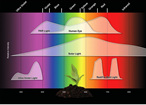How can you better control microclimate in your greenhouse?
By David Hunt, Smart Farming Project Officer

The Smart Farming Partnerships project is funded under the
National Landcare program, Greenlife Industry Australia (GIA)
and Hort Innovation.
Across all horticultural industries there is an increased focus on installing smart technologies to improve production practices and increase sustainability. Selecting the right sensor can improve the control of your greenhouse’s microclimate by manipulating temperature, light intensity, and irrigation, thereby creating an optimal growing environment for your plants.
Recently I attended a Greenhouse Technical Management training course facilitated by Graeme Smith Consulting and the Queensland Government’s Department of Agriculture and Fisheries, and funded by Hort Innovation as part of the Gatton Smart Farms project. The course explored managing a greenhouse microclimate using the data from sensors to manipulate and control how the plants respond to changes in the greenhouse climate.
Although this course mainly focused on managing food and cut flower crops in closed greenhouses, the principles of using smart technologies (or agtech) are the same no matter the type of crop you want to produce. That is, we use the data from the sensors to adjust production processes to produce more product, more efficiently.
The same principles are being used at the Smart Production Nursery in Torbanlea, Queensland as part of the Smart Farming Partnerships project funded by the National Landcare program, Greenlife Industry Australia (GIA) and Hort Innovation.
The main difference between a closed greenhouse and a production nursery is the level of control over the growing environment and the level of plant manipulation. The more control over the environment the easier it is to manipulate temperature, light intensity and irrigation to change a plant from regenerative growth to vegetive growth and back again.
In protected cropping this type of environmental control is used to either shorten production cycles or increase harvest yields. In ornamental plant production the main focus is to produce the healthiest specimen of the plant for sale, not necessarily to induce flowering or fruit production. Now with more plant production industries implementing smart technologies with artificial intelligence, and machine learning, the principles of manipulating the plant growth can be transferred between industries.
One of the benefits of doing the course was to engage with other horticultural industries and identify technologies, management practices and production techniques that can be transferred across to nursery production. The protected cropping industry has been using smart technology and sophisticated control programs for years and has documented various management practices on how plants respond to changes in the growing environment.
Unfortunately, this article is not long enough to fully discuss all aspects of manipulating environmental parameters and how they affect plant production. These techniques will be discussed in future articles, but for now here is a summary of the main principles.
Understanding how solar radiation, ventilation, root zone moisture content, and irrigation timing influence plant growth is critical. The main driver of plant growth is Total or Global solar radiation, this refers to the full light spectrum ranging from ultraviolet to infrared radiation, which delivers both light (45%) and heat (55%). Plants use a portion of the light spectrum known as Photosynthetically Active Radiation (PAR), and humans only see the narrow band known as visible light (see Figure 1).
Too much solar radiation causes heat stress, forcing plants into cooling mode e.g., increasing plant transpiration and water use. The plant’s temperature and amount of solar radiation it receives has a greater influence on that plant’s photosynthesis and transpiration than the air temperature. The 24-hour plant temperature averaged over seven days influences plant development, growth rate, and marketability. In other words, plants can tolerate some heat stress without affecting their quality if there is sufficient water available for transpiration and they have time to recover.
The rate of transpiration is influenced by the humidity of the crop canopy and the available water in the root zone. Reducing canopy humidity by increasing ventilation, increases transpiration, cooling the plant and eventually reduces transpiration as the plant cools. Monitoring root zone moisture content, either by using weight scales or moisture sensors, ensures there is enough water available to drive transpiration while maintaining enough air spaces within the growing media to facilitate oxygen exchange for healthy root growth.
In protected cropping, ventilation and irrigation are usually controlled by sophisticated greenhouse control software that use a variety of sensors, reference charts and calculators to determine the right humidity deficit or how many joules of solar radiation are needed per square centimetre to maintain an optimal growing environment.
As nursery production does not require the same level of plant manipulation as vegetable production, we can use these basic principles to help interpret the data sensors provide. For example, we can use an onsite weather station to monitor solar radiation at crop level in conjunction with media moisture and plant sensors to identify when the plants transpire. Knowing when and how intensely plants transpire can be used to control irrigation scheduling according to the plants’ heat stress.
What all this means, is no matter what plants you grow or what system you use, incorporating some form of smart sensors to help maintain an optimal growing environment does not have to be overwhelming. There is a lot of information and proven management principles available that can help to identify the best climate parameters. We just need to understand which sensors provide the right information when choosing technology, and it may take some time or a little training to get it right, but smart technologies or agtech can improve production efficiencies.
……………………………………………………………………………..
FREE Smart Farming workshop! Melbourne – 25 October 2022
David Hunt, Smart Farming Project Officer, and Kimberley Thomas, GIA Extension Officer are conducting a free Smart Farming workshop to showcase the technology installed at the Golden Grove Smart Production Nursery. For more information about this workshop, including registration details, please click here.
NB. This is the first in a series of such workshops to be delivered across the country.





